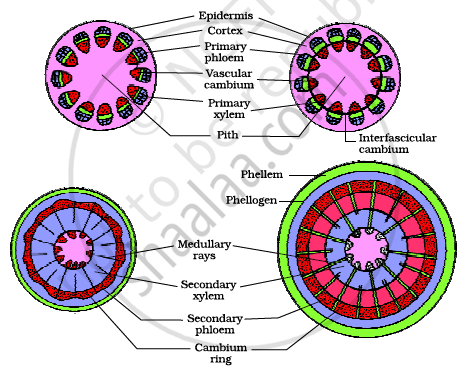Advertisements
Advertisements
प्रश्न
Explain the process of secondary growth in stems of woody angiosperm with help of schematic diagrams. What is the significance?
उत्तर १
Secondary growth is the formation of secondary tissues from lateral meristems. It is found in dicots only. It increases the diameter of the stem. Secondary tissues are formed by two types of lateral meristems, vascular cambium and cork cambium. Vascular cambium produces secondary vascular tissues while cork cambium forms periderm.The vascular bundles in dicot stem are conjoint, collateral, open and are arranged in a ring. The cambium present between xylem and phloem in vascular bundles is called fascicular or intrafascicular cambium. Besides this, some cells of medullary rays also become meristematic and this is called interfascicular cambium. Both these cambia collectively constitute complete ring of vascular cambium. This ring of vascular cambium divides periclinally to cut off cells both on inner side and outer side. The cells cuts off on outer side are secondary phloem and inner side are secondary xylem. Amount of secondary xylem cut off is more than secondary phloem and thus with the formation of secondary tissue, increase in girth or diameter occurs. The structure of secondary xylem and secondary phloem is similar to that of primary xylem and primary phloem. With the increase in secondary tissue, the primary xylem and primary phloem get crushed. The ray initials of vascular cambium ring divide by tangential divisions and add new cells. These new cells produced on both the sides of ray initials remain meristematic for sometime and then differentiate into parenchymatous cells of rays. The rays, produced by vascular cambium in between the secondary xylem and secondary phloem, are called secondary medullary rays. They are usually one to few layers in thickness and one to several layers in height. The medullary rays form the radial systejn responsible for radial conduction of solutes. They maintain connection between pith and cortex There is a marked difference in activity of cambium with change in season. In spring, the activity of cambium is more and hence the wood elements are larger in size with wide lumen. The activity of cambium is less during autumn and the wood elements are smaller in size with narrow lumen. Spring wood and autumn wood of a year constitute annual ring.
In order to increase in girth and prevent harm on the rupturing of the outer ground tissues due to the formation of secondary vascular tissues, dicot stems produce a cork cambium or phellogen in the outer cortical cells. Phellogen cells divide on both the outer side as well as the inner side to form secondary tissues. The secondary tissue formed on the inner side is called secondary cortex while the tissue formed on outer side is called cork

उत्तर २
In woody dicots, the strip of cambium present between the primary xylem and phloem is called the interfascicular cambium. The interfascicular cambium is formed from the cells of the medullary rays adjoining the interfascicular cambium. This results in the formation of a continuous cambium ring. The cambium cuts off new cells toward its either sides. The cells present toward the outside differentiate into the secondary phloem, while the cells cut off toward the pith give rise to the secondary xylem. The amount of the secondary xylem produced is more than that of the secondary phloem.

Secondary growth in a dicot stem
The secondary growth in plants increases the girth of plants, increases the amount of water and nutrients to support the growing number of leaves, and also provides support to plants.
